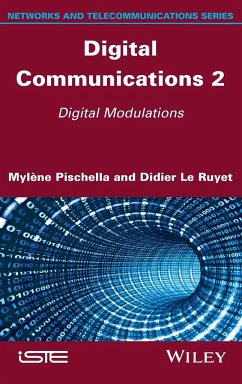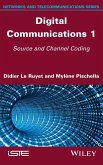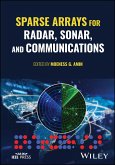- Gebundenes Buch
- Merkliste
- Auf die Merkliste
- Bewerten Bewerten
- Teilen
- Produkt teilen
- Produkterinnerung
- Produkterinnerung
This second volume covers the following blocks in the chain of communication: the modulation baseband and transposed band, synchronization and channel estimation as well as detection. Variants of these blocks, the multicarrier modulation and coded modulations are used in current systems or future.
Andere Kunden interessierten sich auch für
![Digital Communications 1 Digital Communications 1]() Didier Le RuyetDigital Communications 1169,99 €
Didier Le RuyetDigital Communications 1169,99 €![Power Line Communications Power Line Communications]() Power Line Communications158,99 €
Power Line Communications158,99 €![Mobile Edge Computing and Communications Mobile Edge Computing and Communications]() Aaron Yi DingMobile Edge Computing and Communications122,99 €
Aaron Yi DingMobile Edge Computing and Communications122,99 €![Compact Antennas for Wireless Communications and Terminals Compact Antennas for Wireless Communications and Terminals]() Compact Antennas for Wireless Communications and Terminals166,99 €
Compact Antennas for Wireless Communications and Terminals166,99 €![Sparse Arrays for Radar, Sonar, and Communications Sparse Arrays for Radar, Sonar, and Communications]() Sparse Arrays for Radar, Sonar, and Communications143,99 €
Sparse Arrays for Radar, Sonar, and Communications143,99 €![Digital Communications Digital Communications]() Mehmet SafakDigital Communications119,99 €
Mehmet SafakDigital Communications119,99 €![Quantum Communications in New Telecommunications Systems Quantum Communications in New Telecommunications Systems]() Malek BenslamaQuantum Communications in New Telecommunications Systems170,99 €
Malek BenslamaQuantum Communications in New Telecommunications Systems170,99 €-
-
-
This second volume covers the following blocks in the chain of communication: the modulation baseband and transposed band, synchronization and channel estimation as well as detection. Variants of these blocks, the multicarrier modulation and coded modulations are used in current systems or future.
Hinweis: Dieser Artikel kann nur an eine deutsche Lieferadresse ausgeliefert werden.
Hinweis: Dieser Artikel kann nur an eine deutsche Lieferadresse ausgeliefert werden.
Produktdetails
- Produktdetails
- Verlag: Wiley
- Seitenzahl: 334
- Erscheinungstermin: 12. Oktober 2015
- Englisch
- Abmessung: 240mm x 161mm x 22mm
- Gewicht: 663g
- ISBN-13: 9781848218468
- ISBN-10: 184821846X
- Artikelnr.: 43166130
- Herstellerkennzeichnung
- Libri GmbH
- Europaallee 1
- 36244 Bad Hersfeld
- gpsr@libri.de
- Verlag: Wiley
- Seitenzahl: 334
- Erscheinungstermin: 12. Oktober 2015
- Englisch
- Abmessung: 240mm x 161mm x 22mm
- Gewicht: 663g
- ISBN-13: 9781848218468
- ISBN-10: 184821846X
- Artikelnr.: 43166130
- Herstellerkennzeichnung
- Libri GmbH
- Europaallee 1
- 36244 Bad Hersfeld
- gpsr@libri.de
Didier Le Ruyet received his Eng. Degree and his Ph. D. degree from Conservatoire National des Arts et Métiers (CNAM) in 1994 and 2001 respectively. In 2009, he received the "Habilitation à diriger des recherches" from Paris XIII University. He is full professor at CNAM since 2010 and deputy director of the center for research in Computer Science and Telecommunications (CEDRIC). He has published about 100 papers in refereed journals and conference proceedings. His main research and teaching activities lie in the areas of digital communication, wireless communication and signal processing including channel coding and multi-antenna transmission. Mylène Pischella received her engineering degree and her phD in electronics and telecommunications from Télécom ParisTech. She is an associate professor at Conservatoire National des Arts et Métiers (CNAM), where she is responsible of courses on digital communications, wireless communications and information theory.
Preface xi
List of Acronyms xiii
Notations. xvii
Introduction xix
Chapter 1. Background 1
1.1. Introduction 1
1.2. Common operations and functions 1
1.2.1. Convolution 1
1.2.2. Scalar product 2
1.2.3. Dirac function, Dirac impulse and Kronecker's symbol 2
1.2.4. Step function 3
1.2.5. Rectangular function 3
1.3. Common transforms 3
1.3.1. Fourier transform 3
1.3.2. The z transform 6
1.4. Probability background 6
1.4.1. Discrete random variables 7
1.4.2. Continuous random variables 9
1.4.3. Jensen's inequality 9
1.4.4. Random signals 10
1.5. Background on digital signal processing 13
1.5.1. Sampling 13
1.5.2. Discrete, linear and time-invariant systems 14
1.5.3. Finite impulse response filters 17
1.5.4. Infinite impulse response filters 17
Chapter 2. Baseband Transmissions 19
2.1. Introduction 19
2.2. Line codes 20
2.2.1. Non-return to zero (NRZ) code 20
2.2.2. Unipolar return-to-zero (RZ) code 23
2.2.3. Bipolar return-to-zero (RZ) code 25
2.2.4. Manchester code 25
2.2.5. Alternate mark inversion code 26
2.2.6. Miller code 28
2.2.7. Non-return to zero inverted (NRZI) 31
2.2.8. Multi level transmit 3 (MLT-3) code 32
2.2.9. RLL(d,k) codes 33
2.2.10. M-ary NRZ code 35
2.3. Additive white Gaussian noise channel 36
2.4. Optimum reception on the additive white Gaussian noise channel 38
2.4.1. Introduction 38
2.4.2. Modulator's block diagram 39
2.4.3. Optimum receiver for the additive white Gaussian noise channel 44
2.4.4. Evaluation of the bit error rate for the binary NRZ signal on the
additive white Gaussian noise channel 52
2.5. Nyquist criterion 60
2.5.1. Introduction 60
2.5.2. Transmission channel 61
2.5.3. Eye diagram 62
2.5.4. Nyquist criterion 63
2.5.5. Transmit and receive filters with matched filter 66
2.6. Conclusion 68
2.7. Exercises 69
2.7.1. Exercise 1: power spectrum density of several line codes 69
2.7.2. Exercise 2: Manchester code 70
2.7.3. Exercise 3: study of a magnetic recording system 70
2.7.4. Exercise 4: line code and erasure 72
2.7.5. Exercise 5: 4 levels NRZ modulation 73
2.7.6. Exercise 6: Gaussian transmit filter 74
2.7.7. Exercise 7: Nyquist criterion 75
2.7.8. Exercise 8: raised cosine filter 76
Chapter 3. Digital Modulations on Sine Waveforms 77
3.1. Introduction 77
3.2. Passband transmission and equivalent baseband chain 78
3.2.1. Narrowband signal 78
3.2.2. Filtering of a narrowband signal in a passband channel 82
3.2.3. Complex order of a second-order stationary random process 84
3.2.4. Synchronous detection 90
3.3. Linear digital modulations on sine waveforms 92
3.3.1. Main characteristics of linear digital modulations 92
3.3.2. Parameters of an M-symbols modulation 96
3.3.3. Amplitude shift keying 98
3.3.4. Phase shift keying 106
3.3.5. Quadrature amplitude modulations 113
3.3.6. Link between Eb N0 and signal-to-noise ratio depending on the power
values 119
3.3.7. Power spectrum density of regular modulations 120
3.3.8. Conclusion 121
3.4. Frequency shift keying 122
3.4.1. Definitions 122
3.4.2. Discontinuous-phase FSK 124
3.4.3. Continuous-phase FSK 126
3.4.4. Demodulation 126
3.4.5. GMSK modulation 130
3.4.6. Performances 132
3.5. Conclusion 135
3.6. Exercises 135
3.6.1. Exercise 1: constellations of 8-QAM 135
3.6.2. Exercise 2: irregular ASK modulation 136
3.6.3. Exercise 3: comparison of two PSK 137
3.6.4. Exercise 4: comparison of QAM and PSK modulations 137
3.6.5. Exercise 5: comparison of 8-PSK and 8-QAM modulations 138
3.6.6. Exercise 6: comparison of 2-FSK and 2-ASK modulations 139
3.6.7. Exercise 7: comparison of 16-QAM and 16-FSK 140
Chapter 4. Synchronization and Equalization 141
4.1. Introduction 141
4.2. Synchronization 142
4.2.1. Frequency shift correction 144
4.2.2. Time synchronization 150
4.2.3. Channel estimate with training sequence 153
4.2.4. Cramer-Rao's bound 154
4.3. Equalization 157
4.3.1. Channel generating distortions 158
4.3.2. Discrete representation of a channel with inter-symbol interference
and preprocessing 159
4.3.3. Linear equalization 162
4.3.4. Decision-feedback equalization 177
4.3.5. Maximum likelihood sequence estimator 180
4.4. Conclusion 186
4.5. Exercises 187
4.5.1. Exercise 1: estimation of a constant signal from noisy observations
187
4.5.2. Exercise 2: frequency shift correction 188
4.5.3. Exercise 3: zero-forcing equalization 188
4.5.4. Exercise 4: MMSE equalization 189
4.5.5. Exercise 5: MMSE-DFE equalization 190
4.5.6. Exercise 6: MLSE equalization with one shift register 190
4.5.7. Exercise 7: MLSE equalization with two shift registers 190
Chapter 5. Multi-carrier Modulations 193
5.1. Introduction 193
5.2. General principles of multi-carrier modulation 196
5.2.1. Parallel transmission on subcarriers 196
5.2.2. Non-overlapping multi-carrier modulations: FMT 197
5.2.3. Overlapping multi-carrier modulations 198
5.2.4. Chapter's structure 199
5.3. OFDM 199
5.3.1. Transmission and reception in OFDM 201
5.3.2. Cyclic prefix principle 202
5.3.3. Optimum power allocation in OFDM 209
5.3.4. PAPR 215
5.3.5. Sensitivity to asynchronicity 218
5.3.6. OFDM synchronization techniques 219
5.4. FBMC/OQAM 225
5.4.1. Principles of continuous-time FBMC/OQAM 225
5.4.2. Discrete-time notations for FBMC/OQAM 231
5.4.3. Prototype filter 233
5.5. Conclusion 236
5.6. Exercises 236
5.6.1. Exercise 1 236
5.6.2. Exercise 2 237
Chapter 6. Coded Modulations 239
6.1. Lattices 240
6.1.1. Definitions 240
6.1.2. Group properties of a lattice 245
6.1.3. Lattice classification 248
6.1.4. Lattice performances on the additive white Gaussian noise channel
251
6.2. Block-coded modulations 255
6.2.1. Main algebraic constructions of lattices 256
6.2.2. Construction of block-coded modulations 259
6.3. Trellis-coded modulations 270
6.3.1. Construction of trellis-coded modulations 271
6.3.2. Decoding of trellis-coded modulations 275
6.4. Conclusion 276
Appendices 277
Appendix A 279
Appendix B 285
Bibliography 291
Index 297
Summary of Volume 1 299
List of Acronyms xiii
Notations. xvii
Introduction xix
Chapter 1. Background 1
1.1. Introduction 1
1.2. Common operations and functions 1
1.2.1. Convolution 1
1.2.2. Scalar product 2
1.2.3. Dirac function, Dirac impulse and Kronecker's symbol 2
1.2.4. Step function 3
1.2.5. Rectangular function 3
1.3. Common transforms 3
1.3.1. Fourier transform 3
1.3.2. The z transform 6
1.4. Probability background 6
1.4.1. Discrete random variables 7
1.4.2. Continuous random variables 9
1.4.3. Jensen's inequality 9
1.4.4. Random signals 10
1.5. Background on digital signal processing 13
1.5.1. Sampling 13
1.5.2. Discrete, linear and time-invariant systems 14
1.5.3. Finite impulse response filters 17
1.5.4. Infinite impulse response filters 17
Chapter 2. Baseband Transmissions 19
2.1. Introduction 19
2.2. Line codes 20
2.2.1. Non-return to zero (NRZ) code 20
2.2.2. Unipolar return-to-zero (RZ) code 23
2.2.3. Bipolar return-to-zero (RZ) code 25
2.2.4. Manchester code 25
2.2.5. Alternate mark inversion code 26
2.2.6. Miller code 28
2.2.7. Non-return to zero inverted (NRZI) 31
2.2.8. Multi level transmit 3 (MLT-3) code 32
2.2.9. RLL(d,k) codes 33
2.2.10. M-ary NRZ code 35
2.3. Additive white Gaussian noise channel 36
2.4. Optimum reception on the additive white Gaussian noise channel 38
2.4.1. Introduction 38
2.4.2. Modulator's block diagram 39
2.4.3. Optimum receiver for the additive white Gaussian noise channel 44
2.4.4. Evaluation of the bit error rate for the binary NRZ signal on the
additive white Gaussian noise channel 52
2.5. Nyquist criterion 60
2.5.1. Introduction 60
2.5.2. Transmission channel 61
2.5.3. Eye diagram 62
2.5.4. Nyquist criterion 63
2.5.5. Transmit and receive filters with matched filter 66
2.6. Conclusion 68
2.7. Exercises 69
2.7.1. Exercise 1: power spectrum density of several line codes 69
2.7.2. Exercise 2: Manchester code 70
2.7.3. Exercise 3: study of a magnetic recording system 70
2.7.4. Exercise 4: line code and erasure 72
2.7.5. Exercise 5: 4 levels NRZ modulation 73
2.7.6. Exercise 6: Gaussian transmit filter 74
2.7.7. Exercise 7: Nyquist criterion 75
2.7.8. Exercise 8: raised cosine filter 76
Chapter 3. Digital Modulations on Sine Waveforms 77
3.1. Introduction 77
3.2. Passband transmission and equivalent baseband chain 78
3.2.1. Narrowband signal 78
3.2.2. Filtering of a narrowband signal in a passband channel 82
3.2.3. Complex order of a second-order stationary random process 84
3.2.4. Synchronous detection 90
3.3. Linear digital modulations on sine waveforms 92
3.3.1. Main characteristics of linear digital modulations 92
3.3.2. Parameters of an M-symbols modulation 96
3.3.3. Amplitude shift keying 98
3.3.4. Phase shift keying 106
3.3.5. Quadrature amplitude modulations 113
3.3.6. Link between Eb N0 and signal-to-noise ratio depending on the power
values 119
3.3.7. Power spectrum density of regular modulations 120
3.3.8. Conclusion 121
3.4. Frequency shift keying 122
3.4.1. Definitions 122
3.4.2. Discontinuous-phase FSK 124
3.4.3. Continuous-phase FSK 126
3.4.4. Demodulation 126
3.4.5. GMSK modulation 130
3.4.6. Performances 132
3.5. Conclusion 135
3.6. Exercises 135
3.6.1. Exercise 1: constellations of 8-QAM 135
3.6.2. Exercise 2: irregular ASK modulation 136
3.6.3. Exercise 3: comparison of two PSK 137
3.6.4. Exercise 4: comparison of QAM and PSK modulations 137
3.6.5. Exercise 5: comparison of 8-PSK and 8-QAM modulations 138
3.6.6. Exercise 6: comparison of 2-FSK and 2-ASK modulations 139
3.6.7. Exercise 7: comparison of 16-QAM and 16-FSK 140
Chapter 4. Synchronization and Equalization 141
4.1. Introduction 141
4.2. Synchronization 142
4.2.1. Frequency shift correction 144
4.2.2. Time synchronization 150
4.2.3. Channel estimate with training sequence 153
4.2.4. Cramer-Rao's bound 154
4.3. Equalization 157
4.3.1. Channel generating distortions 158
4.3.2. Discrete representation of a channel with inter-symbol interference
and preprocessing 159
4.3.3. Linear equalization 162
4.3.4. Decision-feedback equalization 177
4.3.5. Maximum likelihood sequence estimator 180
4.4. Conclusion 186
4.5. Exercises 187
4.5.1. Exercise 1: estimation of a constant signal from noisy observations
187
4.5.2. Exercise 2: frequency shift correction 188
4.5.3. Exercise 3: zero-forcing equalization 188
4.5.4. Exercise 4: MMSE equalization 189
4.5.5. Exercise 5: MMSE-DFE equalization 190
4.5.6. Exercise 6: MLSE equalization with one shift register 190
4.5.7. Exercise 7: MLSE equalization with two shift registers 190
Chapter 5. Multi-carrier Modulations 193
5.1. Introduction 193
5.2. General principles of multi-carrier modulation 196
5.2.1. Parallel transmission on subcarriers 196
5.2.2. Non-overlapping multi-carrier modulations: FMT 197
5.2.3. Overlapping multi-carrier modulations 198
5.2.4. Chapter's structure 199
5.3. OFDM 199
5.3.1. Transmission and reception in OFDM 201
5.3.2. Cyclic prefix principle 202
5.3.3. Optimum power allocation in OFDM 209
5.3.4. PAPR 215
5.3.5. Sensitivity to asynchronicity 218
5.3.6. OFDM synchronization techniques 219
5.4. FBMC/OQAM 225
5.4.1. Principles of continuous-time FBMC/OQAM 225
5.4.2. Discrete-time notations for FBMC/OQAM 231
5.4.3. Prototype filter 233
5.5. Conclusion 236
5.6. Exercises 236
5.6.1. Exercise 1 236
5.6.2. Exercise 2 237
Chapter 6. Coded Modulations 239
6.1. Lattices 240
6.1.1. Definitions 240
6.1.2. Group properties of a lattice 245
6.1.3. Lattice classification 248
6.1.4. Lattice performances on the additive white Gaussian noise channel
251
6.2. Block-coded modulations 255
6.2.1. Main algebraic constructions of lattices 256
6.2.2. Construction of block-coded modulations 259
6.3. Trellis-coded modulations 270
6.3.1. Construction of trellis-coded modulations 271
6.3.2. Decoding of trellis-coded modulations 275
6.4. Conclusion 276
Appendices 277
Appendix A 279
Appendix B 285
Bibliography 291
Index 297
Summary of Volume 1 299
Preface xi
List of Acronyms xiii
Notations. xvii
Introduction xix
Chapter 1. Background 1
1.1. Introduction 1
1.2. Common operations and functions 1
1.2.1. Convolution 1
1.2.2. Scalar product 2
1.2.3. Dirac function, Dirac impulse and Kronecker's symbol 2
1.2.4. Step function 3
1.2.5. Rectangular function 3
1.3. Common transforms 3
1.3.1. Fourier transform 3
1.3.2. The z transform 6
1.4. Probability background 6
1.4.1. Discrete random variables 7
1.4.2. Continuous random variables 9
1.4.3. Jensen's inequality 9
1.4.4. Random signals 10
1.5. Background on digital signal processing 13
1.5.1. Sampling 13
1.5.2. Discrete, linear and time-invariant systems 14
1.5.3. Finite impulse response filters 17
1.5.4. Infinite impulse response filters 17
Chapter 2. Baseband Transmissions 19
2.1. Introduction 19
2.2. Line codes 20
2.2.1. Non-return to zero (NRZ) code 20
2.2.2. Unipolar return-to-zero (RZ) code 23
2.2.3. Bipolar return-to-zero (RZ) code 25
2.2.4. Manchester code 25
2.2.5. Alternate mark inversion code 26
2.2.6. Miller code 28
2.2.7. Non-return to zero inverted (NRZI) 31
2.2.8. Multi level transmit 3 (MLT-3) code 32
2.2.9. RLL(d,k) codes 33
2.2.10. M-ary NRZ code 35
2.3. Additive white Gaussian noise channel 36
2.4. Optimum reception on the additive white Gaussian noise channel 38
2.4.1. Introduction 38
2.4.2. Modulator's block diagram 39
2.4.3. Optimum receiver for the additive white Gaussian noise channel 44
2.4.4. Evaluation of the bit error rate for the binary NRZ signal on the
additive white Gaussian noise channel 52
2.5. Nyquist criterion 60
2.5.1. Introduction 60
2.5.2. Transmission channel 61
2.5.3. Eye diagram 62
2.5.4. Nyquist criterion 63
2.5.5. Transmit and receive filters with matched filter 66
2.6. Conclusion 68
2.7. Exercises 69
2.7.1. Exercise 1: power spectrum density of several line codes 69
2.7.2. Exercise 2: Manchester code 70
2.7.3. Exercise 3: study of a magnetic recording system 70
2.7.4. Exercise 4: line code and erasure 72
2.7.5. Exercise 5: 4 levels NRZ modulation 73
2.7.6. Exercise 6: Gaussian transmit filter 74
2.7.7. Exercise 7: Nyquist criterion 75
2.7.8. Exercise 8: raised cosine filter 76
Chapter 3. Digital Modulations on Sine Waveforms 77
3.1. Introduction 77
3.2. Passband transmission and equivalent baseband chain 78
3.2.1. Narrowband signal 78
3.2.2. Filtering of a narrowband signal in a passband channel 82
3.2.3. Complex order of a second-order stationary random process 84
3.2.4. Synchronous detection 90
3.3. Linear digital modulations on sine waveforms 92
3.3.1. Main characteristics of linear digital modulations 92
3.3.2. Parameters of an M-symbols modulation 96
3.3.3. Amplitude shift keying 98
3.3.4. Phase shift keying 106
3.3.5. Quadrature amplitude modulations 113
3.3.6. Link between Eb N0 and signal-to-noise ratio depending on the power
values 119
3.3.7. Power spectrum density of regular modulations 120
3.3.8. Conclusion 121
3.4. Frequency shift keying 122
3.4.1. Definitions 122
3.4.2. Discontinuous-phase FSK 124
3.4.3. Continuous-phase FSK 126
3.4.4. Demodulation 126
3.4.5. GMSK modulation 130
3.4.6. Performances 132
3.5. Conclusion 135
3.6. Exercises 135
3.6.1. Exercise 1: constellations of 8-QAM 135
3.6.2. Exercise 2: irregular ASK modulation 136
3.6.3. Exercise 3: comparison of two PSK 137
3.6.4. Exercise 4: comparison of QAM and PSK modulations 137
3.6.5. Exercise 5: comparison of 8-PSK and 8-QAM modulations 138
3.6.6. Exercise 6: comparison of 2-FSK and 2-ASK modulations 139
3.6.7. Exercise 7: comparison of 16-QAM and 16-FSK 140
Chapter 4. Synchronization and Equalization 141
4.1. Introduction 141
4.2. Synchronization 142
4.2.1. Frequency shift correction 144
4.2.2. Time synchronization 150
4.2.3. Channel estimate with training sequence 153
4.2.4. Cramer-Rao's bound 154
4.3. Equalization 157
4.3.1. Channel generating distortions 158
4.3.2. Discrete representation of a channel with inter-symbol interference
and preprocessing 159
4.3.3. Linear equalization 162
4.3.4. Decision-feedback equalization 177
4.3.5. Maximum likelihood sequence estimator 180
4.4. Conclusion 186
4.5. Exercises 187
4.5.1. Exercise 1: estimation of a constant signal from noisy observations
187
4.5.2. Exercise 2: frequency shift correction 188
4.5.3. Exercise 3: zero-forcing equalization 188
4.5.4. Exercise 4: MMSE equalization 189
4.5.5. Exercise 5: MMSE-DFE equalization 190
4.5.6. Exercise 6: MLSE equalization with one shift register 190
4.5.7. Exercise 7: MLSE equalization with two shift registers 190
Chapter 5. Multi-carrier Modulations 193
5.1. Introduction 193
5.2. General principles of multi-carrier modulation 196
5.2.1. Parallel transmission on subcarriers 196
5.2.2. Non-overlapping multi-carrier modulations: FMT 197
5.2.3. Overlapping multi-carrier modulations 198
5.2.4. Chapter's structure 199
5.3. OFDM 199
5.3.1. Transmission and reception in OFDM 201
5.3.2. Cyclic prefix principle 202
5.3.3. Optimum power allocation in OFDM 209
5.3.4. PAPR 215
5.3.5. Sensitivity to asynchronicity 218
5.3.6. OFDM synchronization techniques 219
5.4. FBMC/OQAM 225
5.4.1. Principles of continuous-time FBMC/OQAM 225
5.4.2. Discrete-time notations for FBMC/OQAM 231
5.4.3. Prototype filter 233
5.5. Conclusion 236
5.6. Exercises 236
5.6.1. Exercise 1 236
5.6.2. Exercise 2 237
Chapter 6. Coded Modulations 239
6.1. Lattices 240
6.1.1. Definitions 240
6.1.2. Group properties of a lattice 245
6.1.3. Lattice classification 248
6.1.4. Lattice performances on the additive white Gaussian noise channel
251
6.2. Block-coded modulations 255
6.2.1. Main algebraic constructions of lattices 256
6.2.2. Construction of block-coded modulations 259
6.3. Trellis-coded modulations 270
6.3.1. Construction of trellis-coded modulations 271
6.3.2. Decoding of trellis-coded modulations 275
6.4. Conclusion 276
Appendices 277
Appendix A 279
Appendix B 285
Bibliography 291
Index 297
Summary of Volume 1 299
List of Acronyms xiii
Notations. xvii
Introduction xix
Chapter 1. Background 1
1.1. Introduction 1
1.2. Common operations and functions 1
1.2.1. Convolution 1
1.2.2. Scalar product 2
1.2.3. Dirac function, Dirac impulse and Kronecker's symbol 2
1.2.4. Step function 3
1.2.5. Rectangular function 3
1.3. Common transforms 3
1.3.1. Fourier transform 3
1.3.2. The z transform 6
1.4. Probability background 6
1.4.1. Discrete random variables 7
1.4.2. Continuous random variables 9
1.4.3. Jensen's inequality 9
1.4.4. Random signals 10
1.5. Background on digital signal processing 13
1.5.1. Sampling 13
1.5.2. Discrete, linear and time-invariant systems 14
1.5.3. Finite impulse response filters 17
1.5.4. Infinite impulse response filters 17
Chapter 2. Baseband Transmissions 19
2.1. Introduction 19
2.2. Line codes 20
2.2.1. Non-return to zero (NRZ) code 20
2.2.2. Unipolar return-to-zero (RZ) code 23
2.2.3. Bipolar return-to-zero (RZ) code 25
2.2.4. Manchester code 25
2.2.5. Alternate mark inversion code 26
2.2.6. Miller code 28
2.2.7. Non-return to zero inverted (NRZI) 31
2.2.8. Multi level transmit 3 (MLT-3) code 32
2.2.9. RLL(d,k) codes 33
2.2.10. M-ary NRZ code 35
2.3. Additive white Gaussian noise channel 36
2.4. Optimum reception on the additive white Gaussian noise channel 38
2.4.1. Introduction 38
2.4.2. Modulator's block diagram 39
2.4.3. Optimum receiver for the additive white Gaussian noise channel 44
2.4.4. Evaluation of the bit error rate for the binary NRZ signal on the
additive white Gaussian noise channel 52
2.5. Nyquist criterion 60
2.5.1. Introduction 60
2.5.2. Transmission channel 61
2.5.3. Eye diagram 62
2.5.4. Nyquist criterion 63
2.5.5. Transmit and receive filters with matched filter 66
2.6. Conclusion 68
2.7. Exercises 69
2.7.1. Exercise 1: power spectrum density of several line codes 69
2.7.2. Exercise 2: Manchester code 70
2.7.3. Exercise 3: study of a magnetic recording system 70
2.7.4. Exercise 4: line code and erasure 72
2.7.5. Exercise 5: 4 levels NRZ modulation 73
2.7.6. Exercise 6: Gaussian transmit filter 74
2.7.7. Exercise 7: Nyquist criterion 75
2.7.8. Exercise 8: raised cosine filter 76
Chapter 3. Digital Modulations on Sine Waveforms 77
3.1. Introduction 77
3.2. Passband transmission and equivalent baseband chain 78
3.2.1. Narrowband signal 78
3.2.2. Filtering of a narrowband signal in a passband channel 82
3.2.3. Complex order of a second-order stationary random process 84
3.2.4. Synchronous detection 90
3.3. Linear digital modulations on sine waveforms 92
3.3.1. Main characteristics of linear digital modulations 92
3.3.2. Parameters of an M-symbols modulation 96
3.3.3. Amplitude shift keying 98
3.3.4. Phase shift keying 106
3.3.5. Quadrature amplitude modulations 113
3.3.6. Link between Eb N0 and signal-to-noise ratio depending on the power
values 119
3.3.7. Power spectrum density of regular modulations 120
3.3.8. Conclusion 121
3.4. Frequency shift keying 122
3.4.1. Definitions 122
3.4.2. Discontinuous-phase FSK 124
3.4.3. Continuous-phase FSK 126
3.4.4. Demodulation 126
3.4.5. GMSK modulation 130
3.4.6. Performances 132
3.5. Conclusion 135
3.6. Exercises 135
3.6.1. Exercise 1: constellations of 8-QAM 135
3.6.2. Exercise 2: irregular ASK modulation 136
3.6.3. Exercise 3: comparison of two PSK 137
3.6.4. Exercise 4: comparison of QAM and PSK modulations 137
3.6.5. Exercise 5: comparison of 8-PSK and 8-QAM modulations 138
3.6.6. Exercise 6: comparison of 2-FSK and 2-ASK modulations 139
3.6.7. Exercise 7: comparison of 16-QAM and 16-FSK 140
Chapter 4. Synchronization and Equalization 141
4.1. Introduction 141
4.2. Synchronization 142
4.2.1. Frequency shift correction 144
4.2.2. Time synchronization 150
4.2.3. Channel estimate with training sequence 153
4.2.4. Cramer-Rao's bound 154
4.3. Equalization 157
4.3.1. Channel generating distortions 158
4.3.2. Discrete representation of a channel with inter-symbol interference
and preprocessing 159
4.3.3. Linear equalization 162
4.3.4. Decision-feedback equalization 177
4.3.5. Maximum likelihood sequence estimator 180
4.4. Conclusion 186
4.5. Exercises 187
4.5.1. Exercise 1: estimation of a constant signal from noisy observations
187
4.5.2. Exercise 2: frequency shift correction 188
4.5.3. Exercise 3: zero-forcing equalization 188
4.5.4. Exercise 4: MMSE equalization 189
4.5.5. Exercise 5: MMSE-DFE equalization 190
4.5.6. Exercise 6: MLSE equalization with one shift register 190
4.5.7. Exercise 7: MLSE equalization with two shift registers 190
Chapter 5. Multi-carrier Modulations 193
5.1. Introduction 193
5.2. General principles of multi-carrier modulation 196
5.2.1. Parallel transmission on subcarriers 196
5.2.2. Non-overlapping multi-carrier modulations: FMT 197
5.2.3. Overlapping multi-carrier modulations 198
5.2.4. Chapter's structure 199
5.3. OFDM 199
5.3.1. Transmission and reception in OFDM 201
5.3.2. Cyclic prefix principle 202
5.3.3. Optimum power allocation in OFDM 209
5.3.4. PAPR 215
5.3.5. Sensitivity to asynchronicity 218
5.3.6. OFDM synchronization techniques 219
5.4. FBMC/OQAM 225
5.4.1. Principles of continuous-time FBMC/OQAM 225
5.4.2. Discrete-time notations for FBMC/OQAM 231
5.4.3. Prototype filter 233
5.5. Conclusion 236
5.6. Exercises 236
5.6.1. Exercise 1 236
5.6.2. Exercise 2 237
Chapter 6. Coded Modulations 239
6.1. Lattices 240
6.1.1. Definitions 240
6.1.2. Group properties of a lattice 245
6.1.3. Lattice classification 248
6.1.4. Lattice performances on the additive white Gaussian noise channel
251
6.2. Block-coded modulations 255
6.2.1. Main algebraic constructions of lattices 256
6.2.2. Construction of block-coded modulations 259
6.3. Trellis-coded modulations 270
6.3.1. Construction of trellis-coded modulations 271
6.3.2. Decoding of trellis-coded modulations 275
6.4. Conclusion 276
Appendices 277
Appendix A 279
Appendix B 285
Bibliography 291
Index 297
Summary of Volume 1 299








